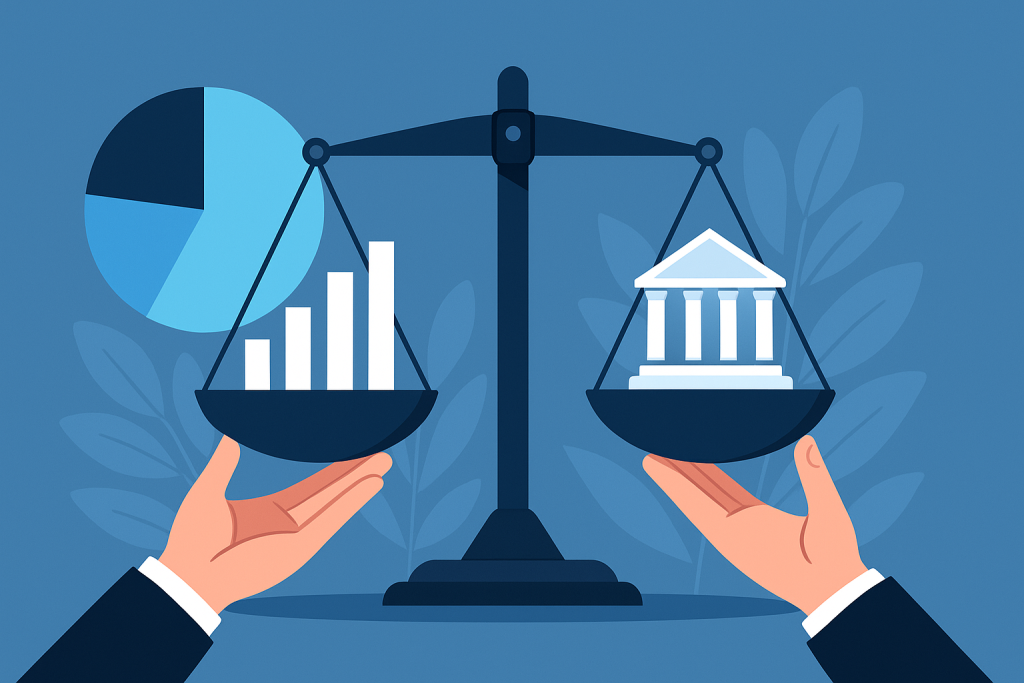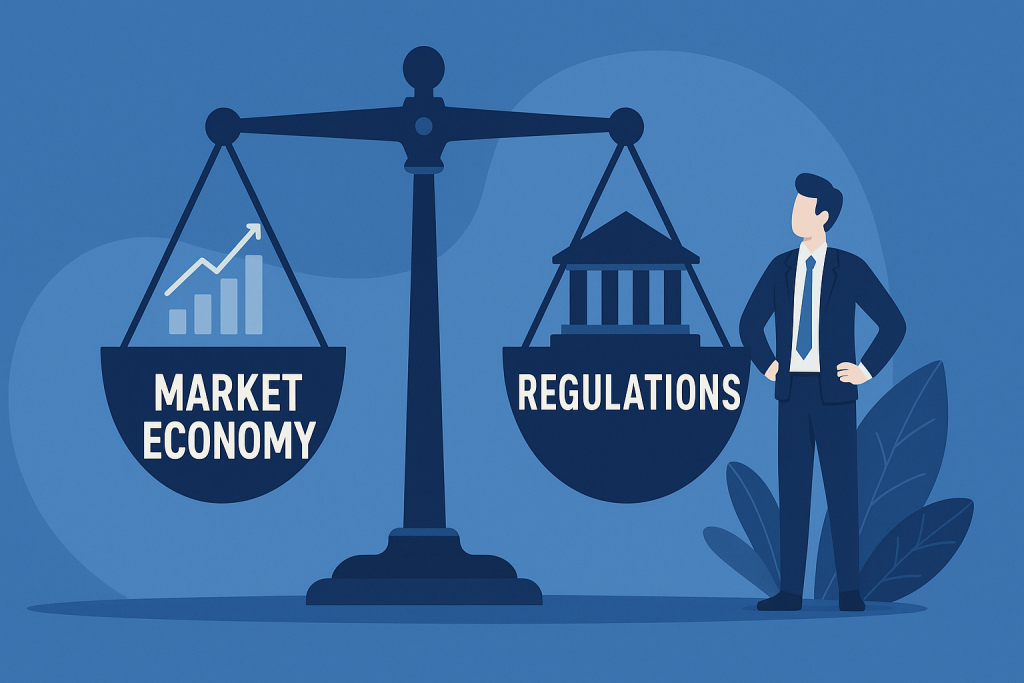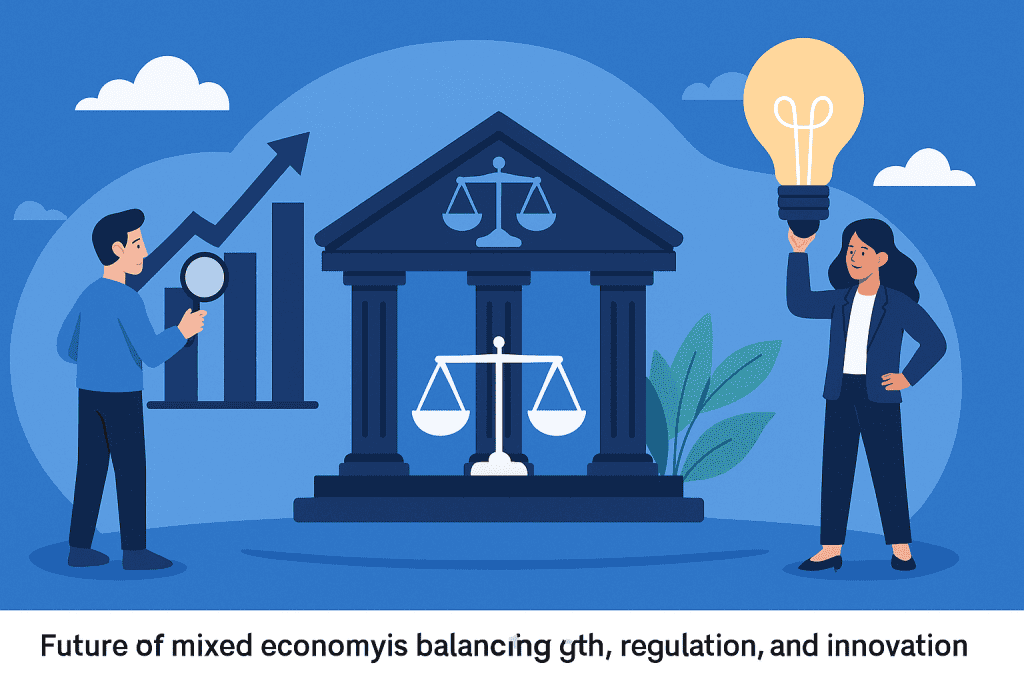
What if an economic system could balance free enterprise and government intervention? That’s exactly what a mixed economy aims to do. It takes the best aspects of capitalism and socialism, creating a hybrid system used by many countries, including the United States. But is this the ideal solution, or does it come with hidden drawbacks?
A System That Bridges Two Worlds
A mixed economy is a combination of market and command economic principles. It allows private businesses to operate freely but also permits government intervention when necessary. This approach seeks to balance economic efficiency with social welfare.
Key Characteristics of a Mixed Economy
A mixed economy has the following core elements:
- Private and public ownership – Businesses and individuals can own property, but the government controls key industries like healthcare and transportation.
- Regulated competition – While businesses compete freely, government policies prevent monopolies and ensure fair trade.
- Government intervention – The state steps in during financial crises, economic downturns, or cases of social inequality.
- Social programs – Public education, welfare, and healthcare systems ensure basic needs are met.
Why Do Countries Choose a Mixed Economy?
Many nations, including the United States, adopt a mixed economy because it offers both economic growth and social stability. The market allows businesses to innovate and expand, while the government provides regulations to prevent exploitation and economic collapse.
The Role of Government in a Mixed Economy: In a mixed economy, the government plays a crucial role in maintaining balance between free-market forces and public welfare. While private enterprises drive innovation and economic growth, government intervention ensures stability, fairness, and long-term sustainability.
Price Controls
One of the government’s key functions is regulating prices to prevent unfair market practices. In times of economic crisis or high inflation, price controls can be implemented to keep essential goods and services affordable for the public. However, excessive control can sometimes lead to shortages and inefficiencies.
Minimum Wage Laws
To protect workers from exploitation, governments in mixed economies set minimum wage laws. This ensures that employees receive fair compensation for their labor, improving overall living standards. However, high minimum wages can increase labor costs for businesses, sometimes leading to job cuts or higher consumer prices.
Antitrust Laws
Competition is essential for a thriving economy, and governments enforce antitrust laws to prevent monopolies and unfair business practices. These regulations promote a competitive market, ensuring that no single company dominates an industry at the expense of consumers and smaller businesses.
Welfare Programs
A significant aspect of government involvement in a mixed economy is providing social welfare programs. These programs, such as unemployment benefits, healthcare, and public education, help reduce economic inequality and provide support for vulnerable populations. While these initiatives improve quality of life, they also require funding through taxes, which can be a point of debate regarding economic efficiency and personal responsibility.
Crisis Intervention
During financial downturns, the government steps in to stabilize the economy through measures like stimulus packages, interest rate adjustments, and job creation programs. For example, in the United States, the Federal Reserve plays a critical role in regulating inflation and controlling interest rates to maintain economic stability.
Real-World Examples of Mixed Economies
United States
The U.S. has a strong capitalist market but also government-run programs like Social Security and Medicaid.
Germany
The government regulates industries while allowing businesses to compete globally.
Sweden
A balance of high taxes and a strong welfare system with a thriving private sector.
How Does Innovation Shape a Mixed Economy?
Advanced technology is rapidly transforming economic systems, and a mixed economy is uniquely positioned to benefit from it. While the market encourages competition in sectors like artificial intelligence and IoT devices, governments fund research and development in industries like healthcare and renewable energy.
New Inventions and Their Impact on Economic Systems
Emerging technologies influence how mixed economies function:
- Artificial Intelligence (AI) – Automates industries while raising questions about job security and regulation.
- IoT Devices – Enhances productivity and efficiency in industries like agriculture and manufacturing.
- Renewable Energy – Governments invest in green technology while allowing private companies to innovate.
The Role of Government in Technological Growth
Governments in mixed economies play a crucial role in supporting innovation by:
- Funding public research institutions.
- Offering grants for startups.
- Regulating emerging industries to prevent monopolies.
Can an Economy Be Truly Free?

A mixed economy walks a fine line between giving businesses freedom and imposing necessary regulations. While a free market allows companies to thrive, excessive government control can stifle innovation.
The Pros and Cons of a Mixed Economy
A mixed economy combines elements of both market and command systems, aiming to create a balance between economic freedom and government intervention. While this approach allows businesses to thrive and encourages innovation, it also ensures regulations are in place to protect consumers and workers. However, like any economic system, a mixed economy has its advantages and disadvantages. Let’s explore the key pros and cons of this system.
| Pros | Cons |
|---|---|
| Encourages growth – Businesses can expand without excessive restrictions. | Overregulation risks – Too much government control can slow down business growth. |
| Protects workers – Labor laws and minimum wages ensure fair treatment. | Tax burdens – Higher taxes may discourage investment. |
| Prevents economic crises – Government intervention stabilizes financial downturns. | Bureaucratic inefficiency – Government programs can be slow and costly. |
How the United States Uses a Mixed Economy
The United States exemplifies a mixed economy, blending free-market principles with government intervention. While businesses operate with minimal restrictions, federal regulations ensure consumer protection, fair wages, and economic stability.
Examples of Government Involvement in the U.S. Economy
- Federal Reserve – Regulates inflation and controls interest rates.
- Social Security and Medicare – Government-run programs that provide financial and healthcare security.
- Antitrust Laws – Prevent corporations from becoming too powerful.
Does a Mixed Economy Offer the Best Future?

Many economists believe a mixed economy is the most sustainable economic system in today’s world. It provides flexibility, allowing nations to adjust their policies based on economic conditions.
The Role of Advanced Technology in the Future
The future of mixed economies will be shaped by:
- Automation and AI – How much should governments regulate AI-driven industries?
- Universal Basic Income (UBI) – Should governments provide financial security as jobs become automated?
- Globalization – How do mixed economies compete in an interconnected world?
Conclusion
A mixed economy blends the best aspects of market and command economies, making it a practical choice for many nations. By leveraging advanced technology, embracing innovation, and balancing regulation with freedom, this system continues to evolve. While it offers stability and growth, it also presents challenges that require ongoing adjustments. Will a mixed economy remain the dominant model in the future, or will economic systems evolve further?
Resources
- Corporate Finance Institute – Mixed Economic System
- Investopedia – Mixed Economic System Definition
- Lumen Learning – The Benefits of Mixed Economies
- Wall Street Prep – Mixed Economy
- YouTube – Video on Mixed Economy
- Homework Helpr – Study Guide on Mixed Economy
